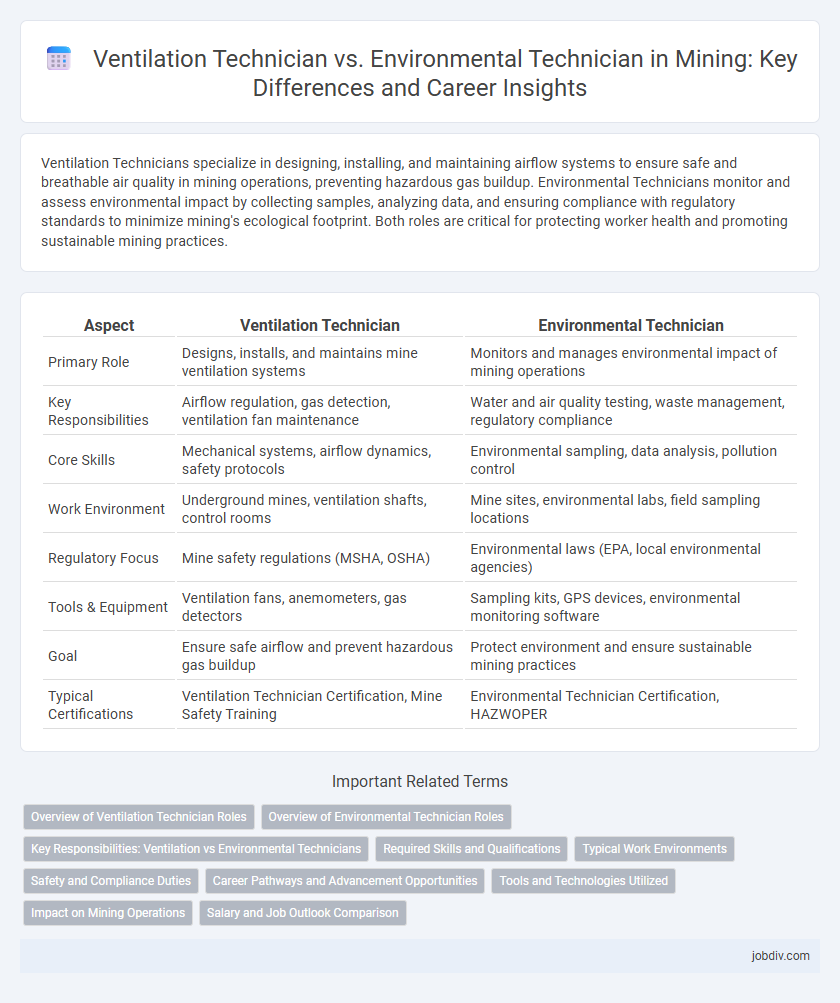Ventilation Technicians specialize in designing, installing, and maintaining airflow systems to ensure safe and breathable air quality in mining operations, preventing hazardous gas buildup. Environmental Technicians monitor and assess environmental impact by collecting samples, analyzing data, and ensuring compliance with regulatory standards to minimize mining's ecological footprint. Both roles are critical for protecting worker health and promoting sustainable mining practices.
Table of Comparison
| Aspect | Ventilation Technician | Environmental Technician |
|---|---|---|
| Primary Role | Designs, installs, and maintains mine ventilation systems | Monitors and manages environmental impact of mining operations |
| Key Responsibilities | Airflow regulation, gas detection, ventilation fan maintenance | Water and air quality testing, waste management, regulatory compliance |
| Core Skills | Mechanical systems, airflow dynamics, safety protocols | Environmental sampling, data analysis, pollution control |
| Work Environment | Underground mines, ventilation shafts, control rooms | Mine sites, environmental labs, field sampling locations |
| Regulatory Focus | Mine safety regulations (MSHA, OSHA) | Environmental laws (EPA, local environmental agencies) |
| Tools & Equipment | Ventilation fans, anemometers, gas detectors | Sampling kits, GPS devices, environmental monitoring software |
| Goal | Ensure safe airflow and prevent hazardous gas buildup | Protect environment and ensure sustainable mining practices |
| Typical Certifications | Ventilation Technician Certification, Mine Safety Training | Environmental Technician Certification, HAZWOPER |
Overview of Ventilation Technician Roles
Ventilation Technicians in mining are responsible for designing, implementing, and maintaining ventilation systems to ensure safe air quality and control hazardous gases underground. Their role involves monitoring airflow, inspecting ventilation equipment, and complying with safety regulations to prevent environmental and health risks. Unlike Environmental Technicians who focus on broader environmental impact assessments, Ventilation Technicians specialize in airflow management critical to mine safety and operational efficiency.
Overview of Environmental Technician Roles
Environmental Technicians in mining monitor air quality, water quality, and soil conditions to ensure compliance with environmental regulations and minimize ecological impact. They collect samples, perform field tests, and assist in the implementation of environmental management plans to support sustainable mining operations. Their role is crucial in identifying potential environmental hazards and promoting safety standards within the mining site.
Key Responsibilities: Ventilation vs Environmental Technicians
Ventilation Technicians in mining focus on designing, implementing, and maintaining air circulation systems to ensure safe underground air quality by controlling dust, gases, and temperature. Environmental Technicians monitor compliance with environmental regulations, conduct site assessments, and manage waste, water, and soil quality to minimize mining operations' ecological impact. Both roles collaborate to enhance mine safety and sustainability but emphasize different aspects: air management for Ventilation Technicians and environmental protection for Environmental Technicians.
Required Skills and Qualifications
Ventilation Technicians require expertise in airflow dynamics, gas detection, and mechanical systems, along with certifications in mine ventilation and safety compliance to ensure effective air quality control underground. Environmental Technicians focus on environmental monitoring, sample collection, data analysis, and regulatory knowledge related to mining impacts, often holding qualifications in environmental science or relevant technical certifications. Both roles demand strong problem-solving skills, adherence to safety protocols, and proficiency in using specialized instrumentation, but their core competencies differ to address either air quality management or environmental protection in mining operations.
Typical Work Environments
Ventilation Technicians primarily operate underground in mines, ensuring airflow systems maintain safe and breathable conditions within tunnels and shafts. Environmental Technicians work both on-site and in laboratories, monitoring environmental impacts and ensuring compliance with regulations related to air, water, and soil quality around mining operations. Both roles require frequent presence at mining sites, but Ventilation Technicians focus more on underground environments, while Environmental Technicians manage surface and regulatory environments.
Safety and Compliance Duties
Ventilation Technicians ensure underground mine air quality by installing and maintaining ventilation systems that control hazardous gases, heat, and dust, directly enhancing safety and regulatory compliance. Environmental Technicians monitor mine site impacts, manage waste, and implement environmental protection measures to meet federal and state regulations. Both roles are critical in maintaining a safe mining environment, though Ventilation Technicians focus on air safety underground while Environmental Technicians address surface environmental compliance.
Career Pathways and Advancement Opportunities
Ventilation Technicians in mining specialize in designing and maintaining airflow systems essential for underground safety, with career advancement often leading to senior ventilation engineer or mine safety manager roles. Environmental Technicians focus on monitoring and controlling the environmental impact of mining operations, progressing toward environmental compliance officers or sustainability coordinators. Both career pathways offer opportunities in regulatory consulting and corporate environmental health and safety leadership.
Tools and Technologies Utilized
Ventilation Technicians utilize anemometers, gas detectors, and computerized airflow modeling software to monitor and control air quality and circulation within mining operations. Environmental Technicians employ water and soil sampling kits, dust monitoring instruments, and environmental impact assessment software to assess and mitigate the mining activities' effects on surrounding ecosystems. Both roles integrate advanced data analysis tools and real-time monitoring systems to ensure compliance with safety and environmental regulations.
Impact on Mining Operations
Ventilation Technicians ensure safe air quality by managing airflow, gas detection, and dust control, directly reducing health hazards and increasing operational efficiency in underground mining environments. Environmental Technicians monitor compliance with environmental regulations, managing waste, water quality, and soil contamination to minimize ecological impact and avoid costly regulatory penalties. Together, these roles support sustainable mining operations by optimizing worker safety and environmental stewardship, ultimately enhancing productivity and corporate responsibility.
Salary and Job Outlook Comparison
Ventilation Technicians in mining typically earn a median salary ranging from $50,000 to $75,000 annually, reflecting specialized skills in airflow management and mine safety systems. Environmental Technicians in mining usually have salaries between $45,000 and $70,000, focusing on monitoring and mitigating environmental impacts related to mining operations. Job outlook for Ventilation Technicians is projected to grow steadily due to increasing regulatory emphasis on mine safety, while Environmental Technicians are expected to experience moderate growth driven by stricter environmental regulations and sustainability initiatives in the mining industry.
Ventilation Technician vs Environmental Technician Infographic

 jobdiv.com
jobdiv.com